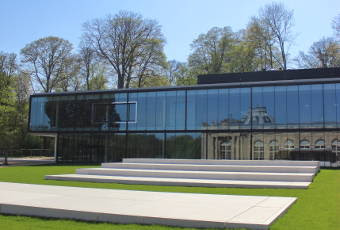When it came to the
renovation, the big challenge was to present a contemporary and decolonised
vision of Africa in a building which had been designed as a colonial museum.
Before the renovation, the
permanent exhibition was outdated and its presentation not very critical of the
colonial image. A new scenography was urgently required. As for the 1910
building, its infrastructure was no longer adapted to the requirements of a modern
museum.
Access to the museum is now
through the new visitor centre, which hosts a ticket office, shop, restaurant,
picnic area for children and cloakrooms.
The visitor walks along the
new underground gallery then heads into the basement of the former edifice,
before resurfacing on the ground floor where the permanent exhibition is
housed.
In the basement of the
museum, an introductory exhibition looks at the past, the present and the
future prospects of the institution. On the ground floor, the exhibition is
divided up into five thematic zones, for the most part dedicated to Central
Africa.
In the inner courtyard of
the museum building, a light shaft has made it possible to create a space for
musical workshops. The tiered seating is ideal for open air theatre.
The listed building was
renovated and restored in keeping with the original plans which date back to
the end of 19th century, whilst at the same time incorporating modern
techniques.
The total surface area
accessible to the public has increased from 6,000 to 11,000m². The scenography is the work of Niek Kortekaas
and Johan Schelfhout. They have created a great balance between the restored
listed windows and the new central platforms.
The introduction of
contemporary art is an important element in the renovation process.
The Congolese artist, Aimé
Mpané was attributed the large rotunda project and created the work Nouveau
souffle ou le Congo bourgeonnant, a large sculpture which enters into dialogue
with the statues of colonial origin.
Given the fact that the
history of the AfricaMuseum and its collections is shared by Belgians and the
people of Central Africa and their diaspora, the institution wanted to involve
them in the development of the permanent exhibition.
http://www.africamuseum.be/en/discover/renovation


No hay comentarios:
Publicar un comentario